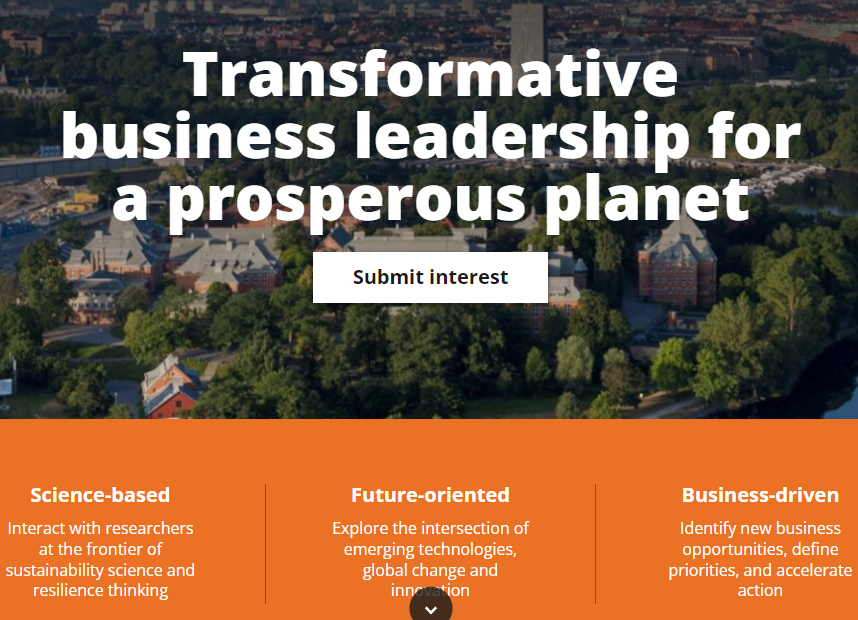Executive programme in resilience thinking

We connect science to business, to accelerate the transformation towards sustainability. The programme is tailor-made for business leaders to take a deep dive into the megatrends shaping our planet and global economy. You will join world-leading scientists, thought leaders, and innovators to explore how to develop your business and lead the way to a sustainable, resilient future.
The executive programme in resilience thinking is tailor-made for business leaders to take a deep dive into the megatrends shaping our planet
and global economy. The programme clarifies what these interconnected changes mean for your company, and highlights business opportunities that also bring social and environmental benefits. You will meet top scholars of resilience thinking and sustainability science as well as thought leaders within business. Together, we will unleash the potential of your business to contribute to a prosperous planet.
- More Info
- Video
- Contact
Challenge Tackled
A new context for business is emerging. The very systems that any business depends on – a stable climate and thriving ecosystems, reliable institutions and access to resources, energy and people – are changing rapidly, as are the expectations from investors, employees and customers. At the same time, advancements in technology, policy and science bring novel opportunities to adapt and transform. More and more businesses discover sustainability as a driver of innovation, competitiveness and value creation. The decisions we make over the next few years will determine the future of many generations to come.
Target group, beneficiaries or clients
Business leaders – CEOs and Chair persons of influential companies, mainly in Sweden.
Solution
The executive programme in resilience thinking is tailor-made for business leaders to take a deep dive into the megatrends shaping our planet and global economy. The programme clarifies what these interconnected changes mean for companies, and highlights business opportunities that also bring social and environmental benefits. Participants meet top scholars of resilience thinking and sustainability science as well as thought leaders within business. The ambition is to unleash the potential of business to contribute to a prosperous planet.
The programme is hosted by the Stockholm Resilience Centre at Stockholm University and developed in collaboration with the Pontus Schultz Foundation.
Innovation
We connect science to business, to accelerate the transformation towards sustainability
Unique Selling Point
Business leaders meet each other and scientists in deep dialogues, based on the best available knowledge about the state of the planet as well as pathways to sustainability.
Key takeaways:
- Gain strategic insights from the latest science on global change and planetary boundaries
- Analyse how your company influences and is influenced by global megatrends
- Identify opportunities for your company to thrive by contributing to a prosperous planet
- Improve your long-term strategy for creating sustainable business value
Impact
The executive programme started in 2018. and every year 16 business leaders take the course. Companies whose leaders have participated include H&M, Electrolux, Atlas Copco, Volvo, Scania, and many more. Together, they reach millions of customers and employees, and their combined turnover is comparable to half of Sweden’s GDP.
Feasibility/Transferability
See above.
Link to projects, other project materials
http://executive.stockholmresilience.org
Contact Person:
https://www.stockholmresilience.org/meet-our-team/how-to-reach-us.html

 4 - Quality Education
4 - Quality Education
The COVID-19 outbreak has caused a global education crisis. Most education systems in the world have been severely affected by education disruptions and have faced unprecedented challenges. School closures brought on by the pandemic have had devastating consequences for children’s learning and well-being. It is estimated that 147 million children missed more than half of their in-class instruction over the past two years. This generation of children could lose a combined total of $17 trillion in lifetime earnings in present value. School closures have affected girls, children from disadvantaged backgrounds, those living in rural areas, children with disabilities and children from ethnic minorities more than their peers.
The proportion of young people completing upper secondary school increased from 54 per cent in 2015 to 58 per cent in 2020, with completion slowing down relative to progress in the preceding five-year period. It is too early to predict the effect of the COVID-19 pandemic on completion. Early indications from low-income countries based on phone surveys point to a small decline in attendance upon a return to school but a larger increase in repetition, which may increase dropout rates in coming years.
Data from 73 (mostly low- and middle-income) countries for the period of 2013-2021, indicate that about 7 in 10 children 3 and 4 years of age are developmentally on track, with no significant differences by child’s sex.
The participation rate in organized learning one year before the official primary entry age rose steadily in the years before the COVID-19 pandemic, from 69 per cent in 2010 to 75 per cent in 2020 but with considerable variation between countries (with the rate ranging from a figure as low as 13 per cent to nearly 100 per cent). This progress is being threatened by the COVID-19 pandemic, as schoolchildren in early childhood education and the early grades, especially from low- and middle-income countries, are the most affected by education disruption. In most countries, early education facilities and schools were partially or fully closed for more than a full school year.
Based on data for 2016-2018, the participation rate of youth and adults in formal and non-formal education and training in the previous 12 months among countries of sub-Saharan Africa with data is typically about 5 per cent or less compared with a rate of over 40 per cent in Northern American and many European countries.

 9 - Industry, Innovation & Infrastructure
9 - Industry, Innovation & Infrastructure
The manufacturing industry exhibited a recovery from the pandemic in 2021, although the rebound has been uneven across countries, with stagnations in least developed countries. Almost one in three jobs in the manufacturing industry were negatively impacted during the pandemic. Higher-technology industries had a better performance and recovered faster, providing a strong example of how important technological innovation is for achieving Sustainable Development Goal 9.
In 2021, global manufacturing activity rose above the pre-pandemic level but the recovery remains incomplete and unequal. Manufacturing in least developed countries stagnated owing to subdued and volatile global demand and disruption to global trade, in addition to tighter domestic economic policies. Despite the pandemic disruptions, the global share of manufacturing value added in total GDP increased from 16.2 per cent in 2015 to 16.9 per cent in 2021. While manufacturing value added per capita in Europe and Northern America reached an all-time high of $5,006 in 2021, in least developed countries it decreased to $134.
Because of the pandemic, nearly one in three jobs in manufacturing supply chains globally are likely to have undergone termination, a reduction in working hours or payment or other worsened conditions. The share of manufacturing employment in total employment thus decreased significantly from 13.7 per cent in 2019 to 13.1 per cent in 2020.
Small industrial enterprises are more vulnerable than larger firms to economic downturns owing to their limited financial resources and greater supply chain dependencies. Although governmental support plays a key role in supporting small enterprises in their efforts to survive and thrive during and after the crisis, such a stimulus is hardly available in low-income countries. Based on survey data from 2006–2020, only 15.7 per cent of small-scale industries in sub-Saharan Africa received loans or lines of credit compared with 44.2 per cent in Latin America and the Caribbean.
Global CO2 emissions declined by 5.8 per cent in 2020 or by almost 2 billion tons, the largest decline since 1990 and almost five times greater than the 2009 decline which followed the global financial crisis. Despite the 2020 decline, global energy-related CO2 emissions remained at 31.5 billion tons, which contributed to the attainment by CO2 of its highest average annual concentration in the atmosphere. In 2021, global energy-related CO2 emissions rose by 6.0 per cent to 36.3 billion metric tons, their highest ever level, as demand for coal, oil and gas rebounded with the economy.
Most of the industries using medium and high technology have reached pre-pandemic levels, except for motor vehicles and other transport equipment. The production of motor vehicles is facing larger challenges worldwide owing to disruptions of the supply chain for resources and intermediate goods. However, the share of medium- and high-technology manufacturing in total manufacturing was only 21.4 per cent in sub-Saharan Africa and 10.5 per cent in least-developed countries, compared with 47.7 per cent in Europe and Northern America in 2019.

 11 - Sustainable Cities & Communities
11 - Sustainable Cities & Communities
As epicentres of the COVID-19 crisis, many cities have suffered from insufficiencies in public health systems, inadequate basic services, a lack of well-developed and integrated public transport systems and inadequate open public spaces, as well as from the economic consequences of lockdowns. As a result, the pandemic is likely to further increase the number of slum dwellers. In order to improve the lives of over 1 billion slum dwellers, there is an urgent need to focus on policies for improving health, affordable housing, basic services, sustainable mobility and connectivity.
Over the years, the number of slum dwellers has continued to grow and that number was over 1 billion in 2020. Slum dwellers are most prevalent in three regions, which are home to about 85 per cent of the world’s slum residents: Central and Southern Asia (359 million), Eastern and South-Eastern Asia (306 million) and sub-Saharan Africa (230 million).
Data for 2020 from 1,510 cities around the world indicate that on average only about 37 per cent of their urban areas are served by public transport, measured as a walking distance of 500 m to low-capacity transport systems (such as buses and trams) and/or 1,000 m to high-capacity systems (such as trains and ferries). Given variations in population concentrations within those cities, this translates into only about 52 per cent of the world population having convenient access to public transport.
In 2022, the global average municipal solid waste collection rate in cities is at 82 per cent and the global average rate of municipal solid waste management in controlled facilities in cities is at 55 per cent. The municipal solid waste collection rates in sub-Saharan Africa and Oceania are less than 60 per cent. Uncollected waste is the source of plastic pollution, greenhouse gas emissions and incubation for infections.
Data for 2020 from 1,072 cities point to a poor distribution of open public spaces in most regions. In these cities, only about 38 per cent of urban areas are loca ted within a walking distance of 400 m to an open public space, which translates into only about 45 per cent of the global urban population having convenient access to those spaces.
By March 2021, a total of 156 countries had developed national urban policies, with almost half (74) already in the implementation stage. A further breakdown shows that 40 per cent of the countries are in the early stages of developing their plans, while 12 per cent are monitoring and evaluating how well those plans are functioning.
By the end of 2021, a total of 98 countries had reported having local governments with disaster risk reduction strategies, an increase from 51 countries in 2015.

 16 - Peace, Justice & Strong Institutions
16 - Peace, Justice & Strong Institutions
Pleas for global peace are growing louder as the world witnesses the highest number of violent conflicts since 1945, with approximately 2 billion people living in conflict-affected countries by the end of 2020. Amid these crises and despite movement restrictions arising from the COVID-19 pandemic, forced displacement has continued to occur and even grow. By the end of 2020, 82.4 million people had been forcibly displaced worldwide, which means that 1 in 95 persons has currently been forcibly displaced. These numbers will increase, as the war in Ukraine is estimated to have already displaced over 7 million people in the country. The costs of war and conflict are high, affecting the poorest and most vulnerable the most and leading to global impacts and escalating humanitarian needs.
Globally, about 437,000 people were victims of homicide in 2020. Between 2015 and 2020, the global homicide rate declined by 5.2 per cent (from 5.9 homicides per 100,000 population to 5.6 per 100,000). Women and girls are disproportionately impacted by lethal violence in the home and account for about 60 per cent of all homicide victims killed by intimate partners or other family members.
The United Nations recorded at least 11,075 civilian conflict-related deaths in 12 of the world’s deadliest armed conflicts in 2021. This translates into 4.1 civilians per 100,000 population; one in eight of those deaths was the death of a woman or child. Compared with 2020, the number of deaths decreased by 26 per cent and by 80 per cent compared with 2015. Despite the overall reduction, many of these situations are fragile, with ongoing and growing risks of escalation and associated violations of international human rights and international humanitarian law. As at 12 April 2022, the Office of the United Nations High Commissioner for Human Rights had recorded the killing of 1,932 civilians in the conflict in Ukraine and the actual figure is considerably higher.
Based on survey data from 114 countries, on average, approximately 69 per cent of the population report feeling safe or very safe walking alone around the area in which E/2022/55 22-06472 23/25 they live after dark, a figure that has remained stable over the period 2016–2021. Women continue to feel significantly less safe than men.
Violence against children is widespread, affecting children regardless of wealth or social status. In 76 countries (mostly low- and middle-income countries) with available data from 2013 to 2021, 8 in 10 children aged 1–14 years were subjected to some form of psychological aggression and/or physical punishment at home in the previous month.
In 2018, for every 10 victims of human trafficking detected globally, about 5 were adult women and 2 were girls. About one third of the overall number of detected victims were children. The sharp increase in unemployment rates brought about by the COVID-19 pandemic is likely to increase trafficking in persons. Ukrainian refugees, mostly women and children, are particularly at risk of human trafficking and exploitation.
Only 60 countries (mostly low- and middle-income countries) have internationally comparable data on sexual violence in childhood against girls and only 12 have produced such data for boys. Across regions with representative estimates in 2020, the prevalence of sexual violence in childhood among young women aged 18–29 years ranges from 2 per cent in Central and Southern Asia to 7 per cent in Oceania (excluding Australia and New Zealand).
By the end of 2020, 11.2 million people were held behind bars compared with just under 11.8 million people in 2019, representing the first decrease in the last two decades. This re-education can be attributed to various factors, including the emergency release of prisoners and reduced admissions of new detainees due to court delays or reduced crime and/or law enforcement activities during the period of the lockdown measures following the outbreak of the Covid-19 pandemic. However, the share of prisoners held in detention without being sentenced was roughly 1 in every 3 prisoners, the same share since 2000.
On average, Member States with available data successfully traced 2 per cent of seized potentially traceable weapons between 2016 and 2020. In 2018–2019, according to available data, national authorities destroyed on average 48 per cent of the weapons seized, found and surrendered.
Globally, almost 1 in 6 businesses faces requests for bribe payments by public officials, based on establishment-level data from 145 countries surveyed during 2006–2021.
Parliaments and their leaders have become younger and more gender-diverse in the past five years. Representation of youth (aged 45 years or under) stood at 28.1 per cent in 2018, climbed to 31.1 per cent in 2021 and then dropped to 30.2 per cent in 2022. While the proportion of women speakers rose gradually from 17.3 per cent in 2018 to 22 per cent in 2022, this continues to be below the global average proportion of women in parliament (26.1 per cent). The proportion of women committee chairs fell from 26.8 per cent in 2021 to 26.2 per cent in 2022. Male parliamentarians aged 46 years or over continue to dominate leadership positions in parliament, holding 71.8 per cent of speaker posts and 60.5 per cent of committee chairs.
